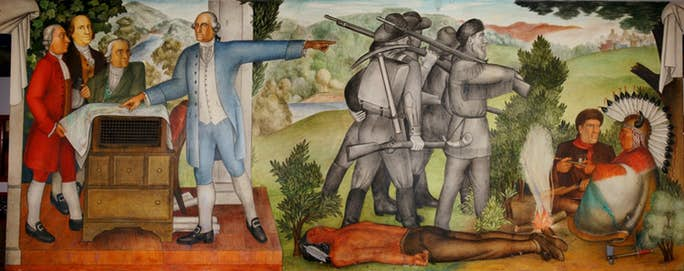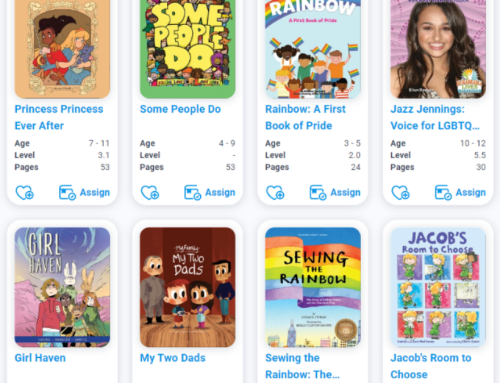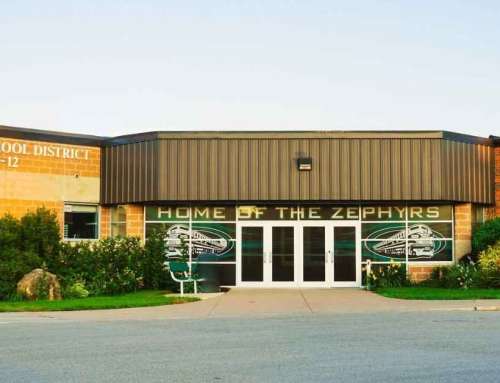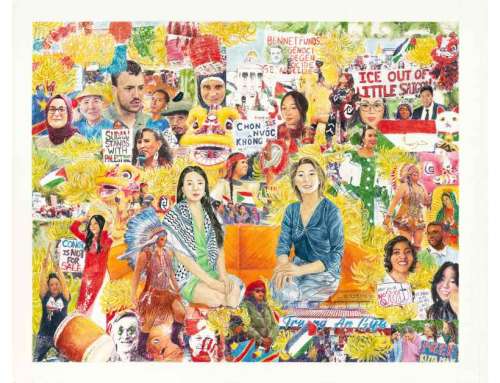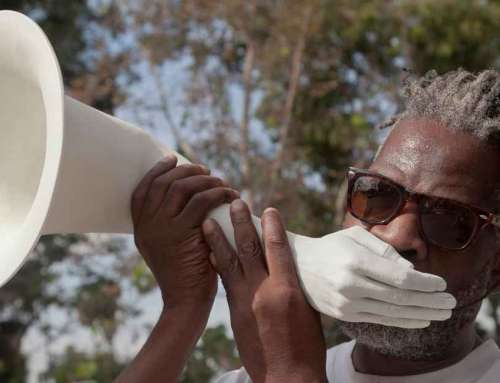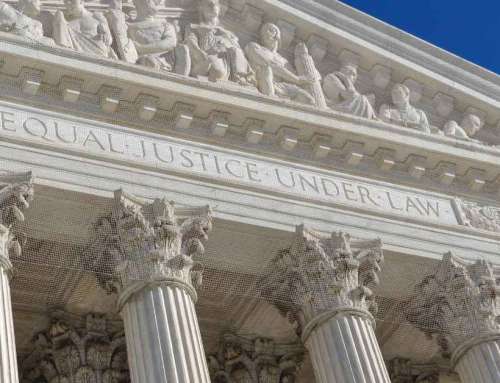UPDATE October 4, 2019: The George Washington High School Alumni Association filed a lawsuit in the public interest against the San Francisco Unified School District Board of Education, challenging the School Board’s commitment to remove from public view Victor Arnautoff’s 1936 New Deal mural with panels without conducting an environmental review, which is required by California law.
UPDATE August 13, 2019: The San Francisco Unified School District voted to reverse their decision to destroy the murals, but to instead cover them with panels. More details available here. NCAC is relieved that these historical murals will be preserved, but hopes that efforts will be made to better contextualize the murals and incorporate them into the school’s curriculum and student experience rather than hiding them away. This controversy has raised important issues of representation, the value of art and the ways in which history is taught and NCAC is hopeful that these conversations continue and additional creative solutions are explored. We will continue to update on this case.
UPDATE August 28, 2019: Senator Dianne Feinstein has written to the San Francisco Unified School District to urge them to neither cover nor destroy the murals, arguing that either would be “to deny our past and to fail our students.”
The Issue
On June 25th, the San Francisco Unified School District (SFUSD) voted to remove 1930s Works Progress Administration (WPA) murals at George Washington High School. At issue are depictions of George Washington’s slaves and violence against Native Americans. The murals, created in fresco by Russian-American social realist painter Victor Arnautoff, can only be removed by the irreversible act of destroying them.
Read more about the original controversy here.
History
The murals cover 1600 square feet of the school’s walls and date to 1936. As they are painted in the buon fresco style, the murals cannot be removed without destroying them. Two of the thirteen murals have drawn heavy criticism for their depictions of black slaves and Native Americans.
The murals were painted by Victor Arnautoff, a Russian-born Communist, for the WPA, a New Deal initiative created by President Franklin D. Roosevelt in 1935. Arnautoff included critiques of Washington in his murals at a time when Washington’s position as a slave owner and disregard for Native Americans were largely ignored. The murals have long been notable for their accurate depiction of both Washington and the nation he lead.
Complaints about the murals first arose in the 1960s, leading the school to commission murals from artist Dewey Crumpler to offer positive imagery of people of color. It appears that a 2017 proposal to designate George Washington High School as a historical landmark reignited calls for the murals to be removed. Following the recent complaints, the school convened a Reflection and Action Group which ultimately recommended that the murals be removed.
The Arguments
The murals’ critics argue that students, particularly Black and Native American students, are traumatized by these images of the historical violence and oppression of their ancestors, and that walking past them at school everyday reinforces structural oppression. They contend that the murals portray people of color in overly-simplistic ways.
Advocates for preserving the murals maintain that this art must be considered in its historical and social context and that arguments for removal do not give students enough credit for their ability to grapple with complexity. Arts advocates and anti-censorship organizations, including NCAC, have called for additional educational programming around the murals and for the school district to explore a wider variety of solutions. The murals’ supporters point to Arnautoff’s critique of Washington, by depicting his oppression and exploitation of slaves and Native Americans, as an important factor to consider in determining the value of these murals. Supporters also suggest that censorship of art is rarely, if ever, a positive outcome. Over 500 signatories, including artists, art historians and academics, have signed onto an open letter calling for the murals to be protected, declaring that “The only viewers who should feel unsafe before this mural are racists.”
NCAC’s Svetlana Mintcheva argued in the San Francisco Chronicle that art is historically targeted during periods of iconoclasm and that more creative solutions should be sought than retain versus destroy.
San Francisco Art Institute Professor Dewey Crumpler has defended the murals in this video produced by the GWHS Alumni Association. Crumpler discusses how they relate to his own murals commissioned in 1974 in response to them. He warns that removing this art is the wrong way to handle the larger issues they raise and that doing so sets a dangerous precedent.
Artist, activist and writer Greg Sholette solicited opinions on the mural controversy from a diverse range of artists, activists and academics. Participants include Amin Husain and Natasha Dhillon, co-founders of Decolonize this Place, who commented that “What’s required here is dialogue with stakeholders at the table with no predetermined outcomes and conditions.” Artist Dread Scott disagrees with the Board’s decision to destroy the murals, saying “the logic of the mural’s detractors would ban much of my work and work like it,” but also sees the widely-circulated open letter in support of the mural as condescending and counter-productive. Sholette also published opinions from Alan Michelson, Tomie Arai, Todd Ayoung, Libertad Guerra, Monxo López and Jeffrey Skoller and the resulting piece presents an array of diverse thought on the issues involved.
The San Francisco Chronicle interviewed students on their perspectives, revealing diverse opinions and deeply-considered reasoning: Of the 17 students who talked with a reporter, 10 said the mural should remain visible. Five of them were black and agreed with Sy that students should be able to continue seeing the mural. Two, both African American, said it should be covered up. And five — including three Asian Americans, one white student and one black student — said they didn’t care either way.
San Francisco Unified School District president Stevon Cook compared defenders of the murals to defenders of Confederate monuments. However, NCAC has argued that Confederate monuments fall into a much different category of government speech and stand as symbols of power, rather than products of artistic vision.
Non-profit education news outlet The 74 Million has looked extensively at several arguments in this debate.
On August 6, San Francisco NAACP leaders have called for the preservation of the murals, stating that “We cannot continue to cut out the things that make us uncomfortable, or we will never grow.”
Over 8,500 people have signed a petition to save the murals.
This information will be updated as more voices join the conversation and additional information becomes available.
Have a suggestion for our reading list? Send it to us at [email protected].


